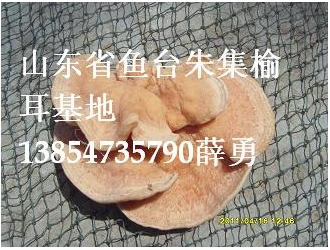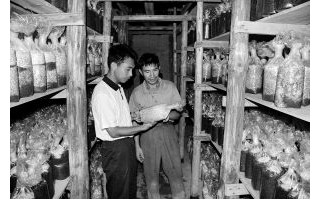RAPD/BSA Analysis on Monokaryotic Strains of Different Mating Types of Auricularia auricula
Abstract:Monokaryotic strains H2 and J3 were respectively developed from the cultivated strains He-1 and Ju-1 of Auricularia auricula through protoplasted monokaryon technique. Dikaryotic strain H2J3 was bred through crossbreeding of H2 and J3 as parents. Fifty-two monokaryotic F1 strains were obtained from the fruitingbodies of dikaryon H2J3 of A. auricula by the single-spore isolation.Auricularia auricula is of the single-factor controlled mating system according to mating test among the F1 progenies and their parents, combining the method of dyeing the nuclei of the mycelia and observing the nuclear phase under the fluorescence microscope and the method of observing the clamp connection under the light microscope to determine whether the dikaryotic mycelia were formed. Based on the mating type phenotype, the F1 progenies were divided into two groups, and two isogenic pools were constructed by mixing equally DNA of the strains of each group. Of 64 random primers, primer S 126 amplified a specific band S1261021 between the two pools, and the amplification result of the progenies and their parents which are of the same mating type suggested that S1261021 is the molecular marker linked to the mating type gene.
Keywords:Auricularia auricula; mating type; haploid strain; RAPD/BSA; molecular marker
黑木耳不同交配型的單倍體菌株RAPD/BSA分析
伍昌勝 黃亞東 邊銀丙
摘 要:從黑木耳(Auricularia auricula)種內(nèi)雜交子H2J3的子實體上單孢分離培養(yǎng)得到F1代52個單核體菌株,將F1子代及親本(H2,J3)等所有供試單核體菌株的菌絲體兩兩配對培養(yǎng),采用核熒光染色觀察核相,和光學(xué)顯微鏡觀察鎖狀聯(lián)合,鑒別菌絲交配反應(yīng)是否形成雙核體菌絲,同時測定了親本菌株所有F1子代的交配型.根據(jù)交配型表型將F1子代菌株分成兩群(F1-A1,F1-A2),將每群內(nèi)各自菌株的DNA等量混合,構(gòu)建交配型基因的等基因池,通過64個隨機引物的RAPD分析,發(fā)現(xiàn)引物S126在2個等基因池間擴增出差異帶S1261021,且在屬于同一交配型的親本及F1子代之間擴增結(jié)果基本一致,表明S1261021是與交配型基因連鎖的分子標記.
關(guān)鍵詞:黑木耳; 交配型; 單倍體菌株; RAPD/BSA; 分子標記
CLC Number:S646.6
Foundation Item:Supported by National Natural Science Foundation (30270931)
Author Resume:Wu Changsheng, male, born in 1976, Ph.D student of Institute of Microbiology, Chinese Academy of Sciences, Beijing 100081.邊銀丙,Corresponding author, bybbybbyb1@vip.sina.com
Author Unit:伍昌勝(華中農(nóng)業(yè)大學(xué)應(yīng)用真菌研究所,武漢,430070)
黃亞東(華中農(nóng)業(yè)大學(xué)應(yīng)用真菌研究所,武漢,430070)
邊銀丙(華中農(nóng)業(yè)大學(xué)應(yīng)用真菌研究所,武漢,430070)
References:
[1]Liu Z T, Luo X C. The biotechnology and application of mushrooms. Beijing:Tsing Hua university Press, 2002. 20~51
[2]Michelmor R W, Paran I, Kesseli R W. Identification of markers linked to disease resistance genes by bulked segregant analysis. Pro Natl Acad Sci USA, 1991, 88:9828~9832
[3]Wu K Y, Bian Y B. Identificating technique of intraspecific hybrids in Auricularia auricula. Mycosystema,2002, 21(2):202~224
[4]Luo X C.The studies on sexuality of Auricularia auricula and Auricularia polytrica.Acta mycological sinica,1988,7(1): 56~61
[5]Kothe E. Mating type genes for basdiomycetes strain improvement in mushroom farming. Microbiol Biotechnol, 2001, 56(Appl): 602~610
[6]Raper J R. Genetics of sexuality in higher fungi. New York:academic press, 1966
[7]Weng Y J, Chen D M. Molecular markers and its clone for salt tolerance gene in wheat. Acta Genetica Sinica, 2002, 29(4):343~349






